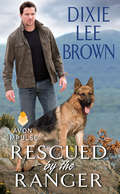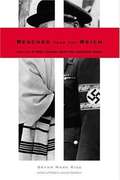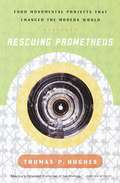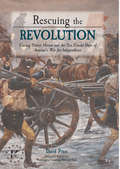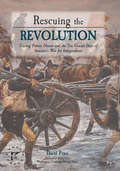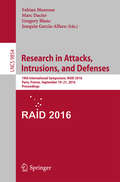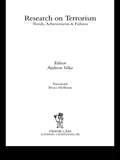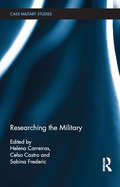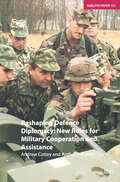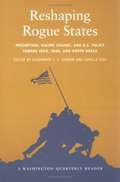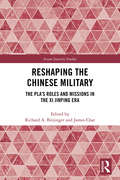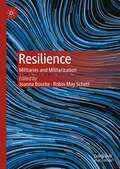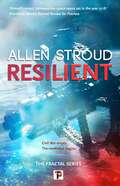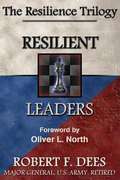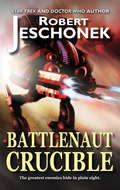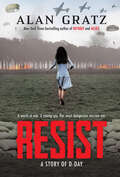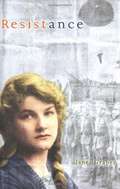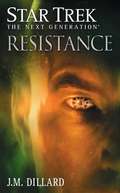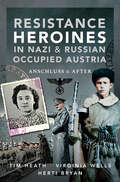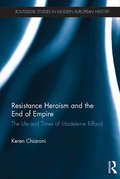- Table View
- List View
Rescue Warriors: The U.S. Coast Guard, America's Forgotten Heroes
by David HelvargThe Extraordinary Story Of The U.S. Coast GuardSince its founding more than two hundred years ago, the United States Coast Guard has rescued over a million people. On any given day, "Coasties" respond to 125 distress calls and save over a dozen lives. Yet despite having more than 50,000 active-duty and reserve members on every ocean and on our nation's coasts, great lakes, and rivers, most of us know very little about this often neglected but crucial branch of the military.In Rescue Warriors, award-winning journalist David Helvarg brings us into the daily lives of Coasties, filled with a salty maritime mix of altruism and adrenaline, as well as dozens of death-defying rescues at sea and on hurricane-ravaged shores.Helvarg spent two years with the men and women of the Coast Guard, from the halls of their academy in New London, Connecticut, to the frigid, storm-tossed waters of Alaska's Bering Sea, to the northern Persian Gulf, where they currently guard Iraqi oil terminals. The result is a masterpiece of adventure reporting---the definitive book on America's "forgotten heroes."
Rescue at Los Baños: The Most Daring Prison Camp Raid of World War II
by Bruce HendersonFrom the New York Times bestselling author of Sons and Soldiers comes the incredible true story of one of the greatest military rescues of all time, the 1945 World War II prison camp raid at Los Baños in the Philippines—a tale of daring, courage, and heroism that joins the ranks of Ghost Soldiers, Unbroken, and The Boys of Pointe du Hoc.In February 1945, as the U.S. victory in the Pacific drew nearer, the Japanese army grew desperate, and its soldiers guarding U.S. and Allied POWs more sadistic. Starved, shot and beaten, many of the 2,146 prisoners of the Los Baños prison camp in the Philippines—most of them American men, women and children—would not survive much longer unless rescued soon.Deeply concerned about the half-starved and ill-treated prisoners, General Douglas MacArthur assigned to the 11th Airborne Division a dangerous rescue mission deep behind enemy lines that became a deadly race against the clock. The Los Baños raid would become one of the greatest triumphs of that war or any war; hailed years later by Chairman of the Joint Chiefs of Staff, General Colin Powell: “I doubt that any airborne unit in the world will ever be able to rival the Los Baños prison raid. It is the textbook operation for all ages and all armies.”Combining personal interviews, diaries, correspondence, memoirs, and archival research, Rescue at Los Baños tells the story of a remarkable group of prisoners—whose courage and fortitude helped them overcome hardship, deprivation, and cruelty—and of the young American soldiers and Filipino guerrillas who risked their lives to save them.
Rescued by the Ranger
by Dixie Lee BrownProtecting those in trouble is what Army Ranger Garrett Harding does best. But after helping a feisty redhead toss a couple of losers from her Idaho bar, the woman is anything but grateful for his assistance--in fact, she seems to know him. Worse, she almost certainly hates him.The only thing Rachel Maguire wants is to send this smart-mouthed, muscled military man packing. She knows Garrett has his own reasons for staying, so when he offers Rachel a deal--two days to prove his worth or he leaves--she reluctantly agrees. Despite wanting to loathe him, Rachel finds herself drawn to his quiet confidence...and the way he fills out a t-shirt.But when Rachel receives a phone call from the past, everything changes. The stalker who destroyed her life ten years ago is closing in once more. Refusing to put anyone else in harm's way, Rachel hits the road hoping to lure danger away from those she loves. But Garrett won't leave this sexy spitfire to face her stalker alone. He'll do anything to protect her. Even if it means risking his life--and his heart.
Rescued from the Reich: How One of Hitler's Soldiers Saved the Lubavitcher Rebbe
by Bryan RiggWhen Hitler invaded Warsaw in the fall of 1939, hundreds of thousands of civilians--many of them Jewish--were trapped in the besieged city. The Rebbe Joseph Schneersohn, the leader of the ultra-orthodox Lubavitcher Jews, was among them. Followers throughout the world were filled with anguish, unable to confirm whether he was alive or dead. Working with officials in the United States government, a group of American Jews initiated what would ultimately become one of the strangest--and most miraculous--rescues of World War II. The escape of Rebbe Schneersohn from Warsaw has been the subject of speculation for decades. Historian Bryan Mark Rigg has now uncovered the true story of the rescue, which was propelled by a secret collaboration between American officials and leaders of German military intelligence. Amid the fog of war, a small group of dedicated German soldiers located the Rebbe and protected him from suspicious Nazis as they fled the city together. During the course of the mission, the Rebbe learned the shocking truth about the leader of the rescue operation, the decorated Wehrmacht soldier Ernst Bloch: he was himself half-Jewish, and a victim of the rising tide of German antisemitism. A harrowing story about identity and moral responsibility, Rescued from the Reich is also a riveting narrative history of one of the most extraordinary rescue missions of World War II.
Rescuing Prometheus: Four Monumental Projects that Changed Our World
by Thomas P. Hughes"A rare insight into industrial planning on a huge scale...Excellent." --The EconomistRescuing Prometheus is an eye-opening and marvelously informative look at some of the technological projects that helped shape the modern world. Thomas P. Hughes focuses on four postwar projects whose vastness and complexity inspired new technology, new organizations, and new management styles. The first use of computers to run systems was developed for the SAGE air defense project. The Atlas missile project was so complicated it required the development of systems engineering in order to complete it. The Boston Central Artery/Tunnel Project tested systems engineering in the complex crucible of a large scale civilian roadway. And finally, the origins of the Internet fostered the collegial management style that later would take over Silicon Valley and define the modern computer industry. With keen insight, Hughes tells these fascinating stories while providing a riveting history of modern technology and the management systems that made it possible.From the Trade Paperback edition.
Rescuing the Revolution: Unsung Patriot Heroes of the Revolution and the Ten Crucial Days of Americas War for Independence
by David PriceThe victories achieved by the American cause during the events from December 25, 1776 to January 3, 1777 in the war for independence from Great Britain were the product of bold and imaginative leadership on the part of George Washington and his fellow generals, miscalculation by the enemy, and the fortuitous effects of weather as it related to the movement of troops and battlefield conditions. But those storied triumphs were also due to the heroic feats of people less well known to history who remain the "unsung heroes" behind our nation's struggle for independence during its darkest days.
Rescuing the Revolution: Unsung Patriot Heroes of the Revolution and the Ten Crucial Days of Americas War for Independence
by David PriceThe victories achieved by the American cause during the events from December 25, 1776 to January 3, 1777 in the war for independence from Great Britain were the product of bold and imaginative leadership on the part of George Washington and his fellow generals, miscalculation by the enemy, and the fortuitous effects of weather as it related to the movement of troops and battlefield conditions. But those storied triumphs were also due to the heroic feats of people less well known to history who remain the “unsung heroes” behind our nation’s struggle for independence during its darkest days.
Research in Attacks, Intrusions, and Defenses
by Joaquin Garcia-Alfaro Fabian Monrose Gregory Blanc Marc DacierThis book constitutes the refereed proceedings of the 18th International Symposium on Research in Attacks, Intrusions and Defenses, RAID 2015, held in Kyoto, Japan, in November 2015. The 28 full papers were carefully reviewed and selected from 119 submissions. This symposium brings together leading researchers and practitioners from academia, government, and industry to discuss novel security problems, solutions, and technologies related to intrusion detection, attacks, and defenses.
Research on Terrorism: Trends, Achievements and Failures (Political Violence Ser.)
by Andrew SilkeThis book brings together leading international experts in the world of terrorism research and counterterrorism policy-making. It has three clear areas of focus:it looks at current issues and trends in terrorism researchit explores how contemporary research on terrorism is focused and conductedit examines how this research impacts in terms of count
Researching the Military (Cass Military Studies)
by Helena Carreiras Celso Castro Sabina FredericResearching the Military focuses on the experiences of researchers who study the military around the world. It explores the historical, social, institutional and personal factors that frame research and scrutinize the way knowledge in this area impacts society and policy. More than merely analyzing research experiences (yet necessarily including them), it is also about the experiences of researchers, their position with regard to the object of their studies, the institutional context where they work and the way their research impacts the academic and policy-making fields in the respective countries. The common theme to the various chapters is reflexivity, a conscious effort at addressing the conditions of research and the position of the researcher and the research participants in that interface. By collecting diverse experiences of researchers from across the world, this volume aims to enhance reflexivity in the field of military studies and to encourage the exchange of knowledge between the academic field and the military arena. This book will be of much interest to students of military studies, research methods, sociology, social anthropology and security studies, in general.
Reshaping Defence Diplomacy: New Roles for Military Cooperation and Assistance (Adelphi series)
by Andrew CotteyAnalyses changing patterns of international military cooperation and assistance and shows that Western defence diplomacy is increasingly being directed towards new goals. The new defence diplomacy runs alongside the old and there are tensions between the two, in particular between the new goal of promoting democracy and the old imperative of supporting authoritarian allies.
Reshaping Rogue States: Preemption, Regime Change, and U.S. Policy Toward Iran, Iraq, and North Korea
by Alexander T. J. Lennon Camille EissIn January 2002, President George W. Bush declared Iran, Iraq, and North Korea constituents of an "axis of evil."
Reshaping the Chinese Military: The PLA's Roles and Missions in the Xi Jinping Era (Asian Security Studies)
by Richard A. Bitzinger James CharThis edited volume examines the recalibration of the People’s Liberation Army’s (PLA) roles and missions in China’s domestic and foreign policymaking since Xi Jinping’s ascension to power in late 2012. This book explores how China’s growing military prowess, along with Beijing’s ongoing shift away from "keeping a low profile," owes much to the policies of the China’s Communist Party under Xi Jinping’s leadership. The chapters in the book share a central theme: the recalibration of the PLA roles and missions since Xi Jinping assumed the trifecta of party-state-military power. These contributions seek to explore in depth some of the key issues and scrutinize the enhancements in the PLA’s operational capabilities, both in terms of its hardware as well as its "heartware" – the human elements of its development such as operational culture and doctrine. In all, the chapters document the transformative change the PLA has undergone since the profound realization of its previous limitations vis-à-vis the United States’ advanced military operations of the previous century as well as pointing to continuity amid change. This book will be of much interest to students of strategic studies, Chinese politics, Asian security, defense studies, and international relations, in general.
Resilience and Military Families: Case Vignettes, Self-Assessment Tools, and Evidence-Based Interventions
by Julie CanfieldThis textbook aims to educate students across all mental health disciplines on the importance of using strengths-based resilience as a tool when working with military families. Organized into three main sections using the military deployment cycle, including the stages of pre-deployment, deployment, and post-deployment, this textbook examines some of the key resiliency skills that operate in military families so that students can understand how many families not only survive, but learn how to thrive, during great challenges. Chapters address the military at home, resilient family systems, the importance of effective communication and social support, the impact of trauma and moral injury, and the transition from military to civilian life following service. Filled with case vignettes, self-assessment tools, and evidence-informed interventions, readers learn multiple ways to measure, assess, and strengthen family resiliency throughout the book. In addition to these skills, specific examples are highlighted that draw lessons from the military community on stress management and posttraumatic growth in the context of family life. The book finishes with an appendix that includes suggestions for therapists on the use of cultural humility to improve treatment.Following two decades of war and a global pandemic, this essential textbook is a crucial read for all mental health professionals training to work with miliary-connected populations and their families. Professionals from disciplines including clinical social work, marriage and family therapy, psychology, healthcare, and theology as well as instructors of courses on military social work, military psychology, and mental health will all find this text an invaluable resource.
Resilience: Militaries and Militarization
by Robin May Schott Joanna BourkeThis book explores the concept of ‘resilience’ in the context of militaries and militarization. Focusing on the U.S., Britain, Canada, Australia, and continental Europe, it argues that, post-9/11, there has been a shift away from ‘trauma’ and towards ‘resilience’ in framing and understanding human responses to calamitous events. The contributors to this volume show how resilience-speech has been militarized, and deeply entrenched in imagined communities. As the concept travels, it is applied in diverse and often contradictory ways to a vast array of experiences, contexts, and scientific fields and disciplines. By embracing diverse methodologies and perspectives, this book reflects on how resilience has been weaponized and employed in highly gendered ways, and how it is central to neoliberal governance in the twenty-first century. While critical of the use of resilience, the chapters also reflects on more positive ways for humans to respond to unforeseen challenges.
Resilient (The Fractal Series #2)
by Allen Stroud&“Stroud raises fascinating questions about the politics of space exploration.&” - Publishers Weekly. The follow-up to the hugely successful Fearless ("...a treat for just about any Analog reader.&” - AnalogSF)"Resilient is one of those incredibly rare things – a sequel that actually improves on its predecessor. Stroud presents us with a complex, multifaceted science-fiction experience that offers a deeply compelling narrative, interlaced with rich and complex world-building and three-dimensional characters." — The Sci-Fi & Fantasy ReviewerAD 2118. Humanity has colonised the Moon, Mars, Ceres and Europa. The partnership of corporations and governments has energized the space programme for one hundred years. That partnership is shattered when a terrorist attack destroys the world&’s biggest solar array in Atacama, Chile, altering the global economic balance.On Mars, at Phobos Station, Doctor Emerson Drake arrives, responding to an emergency call to assist a shuttle of wounded miners, but when those miners turn out to be insurgents, Drake realises he is trapped and fighting to survive. In deep space, Captain Ellisa Shann has passed her limits. Now, the last survivors of the Khidr have to choose whether to try to get home on the captured ship, Gallowglass, or stay to observe the strange gravity anomaly that swallowed up the remains of their vessel.On Earth, in an undisclosed location, Natalie Holder finally has an opportunity to break free from her confinement, where she has been experimented on, multiple times. Her consciousness is transmitted to Phobos Station, just as insurgents take over the facility.Holder and Drake form an alliance but are separated. Drake is captured and taken to the insurgent leader – Rocher – a clone of the stowaway who caused the munity on Captain Shann&’s Khidr.Allen Stroud's Resilient is a masterpiece of hard sci-fi, a worthy follow up from events of his successful and highly-praised Flame Tree Press debut, Fearless.FLAME TREE PRESS is the imprint of long-standing independent Flame Tree Publishing, dedicated to full-length original fiction in the horror and suspense, science fiction & fantasy, and crime / mystery / thriller categories. The list brings together fantastic new authors and the more established; the award winners, and exciting, original voices. Learn more about Flame Tree Press at www.flametreepress.com and connect on social media @FlameTreePress
Resilient Leaders: The Resilience Trilogy
by Bob DeesA Resilient Leader bounces back from the challenges of life and helps others do the same, leading selflessly over time from a platform of character and competence.
Resist the Red Battlenaut
by Robert T. Jeschonek Ben BaldwinThe Red Battlenauts show no mercy. Roaring out of the darkness of deep space, these ultra-high tech war machines pound the hell out of both sides in a bloody interstellar civil war. No one can even see the Reds--no one except Marine Corporal Solomon Scott. Recruited by the hardcore SEAL-like Diamondbacks, Scott becomes a secret weapon in the ultimate struggle for survival. In battle after battle on perilous alien worlds, Scott and the Diamondbacks fight back against the ruthless Reds, desperately holding the line in furious clashes of muscle and metal. But when a face from the past exposes the secrets behind the carnage, a quest for answers becomes a race against time. Because the masters of the Red Battlenauts have more on their minds than a thirst for conquest...and only Solomon Scott can hope to stand against them. In the galaxy's darkest hour, the highest stakes imaginable drive this hero in Battlenaut armor to seize his destiny. But can he overcome a soul-searing betrayal that strikes out of nowhere like the Reds themselves? Only by crushing the monsters of his own dark past can Scott vanquish the forces blasting humanity to the brink of annihilation.Don't miss this exciting sequel to Beware The Black Battlenaut by award-winning storyteller Robert T. Jeschonek, a master of hard-hitting science fiction that really packs a punch. Strap yourself into the cockpit for over 100,000 words of blistering all-new military SF action!Reviews"Jeschonek is a master of military mecha mayhem. Fast-paced, pulse-pounding combat scenes make Resist the Red Battlenaut a must-read in his growing Battlenaut series." - William H. Keith, author of the Grey Death Battlemech novels"Robert Jeschonek is a towering talent..." - Mike Resnick, Hugo and Nebula Award-winning author"Robert Jeschonek is the literary love child of Tim Burton and Neil Gaiman..." - Adrian Phoenix, critically acclaimed author of The Maker's Song series and Black Dust Mambo
Resist: A Story of D-Day
by Alan GratzFrom Alan Gratz, bestselling author of Refugee and Allies, comes an original novella--in ebook!In Allies, Alan Gratz's thrilling novel of D-Day, we met Samira, a young girl who is part of the underground French resistance during World War II. Samira cracks codes and trades secrets in order to sabotage the Nazis' plans.In Resist, we delve deeper into Samira's story. Here, we follow Samira as she journeys through the Nazi-occupied French countryside, on a daring rescue mission to find her captured mother. Accompanied only by a loyal dog named Cyrano, Samira must rely on her courage and wits to avoid and outsmart the German forces. But it's D-Day, and with the Allied forces landing in Europe, fierce battles are raging all around. Can Samira reach her mother and save her in time?This action-packed World War II short story can be read before or after Allies--or entirely on its own!
Resistance
by Anita ShreveAs the wife of a Resistance member in German-occupied Belgium, Claire Daussois has grown used to hiding strange men in her attic. By the end of 1943, the tiny room has housed dozens of Allied airmen, soldiers and other refugees, whom Claire nurses and harbours from the perpetual threat of discovery by the Gestapo.The B-17 bomber that crash-lands outside Claire's village of Delahaut contains the man who will be both the last and the most significant of the attic's residents: US Air Force pilot Ted Brice. Ted is found severely wounded and semi-conscious by ten-year-old Jean Benoit minutes before the Germans begin their search for survivors. Knowing of Claire's connections with the Resistance, and desperate to atone for his father's shameful collaboration, Jean realises that Claire is the pilot's only hope of survival.The month that follows will stay with them both for the rest of their lives. A few weeks only, a handful of days, it is a period in which the war recedes in the face of more powerful forces - before imposing itself once more with shocking suddenness.
Resistance
by Janet GraberIt is 1942, and German troops have invaded France. Marianne's mother has joined the Resistance, and Marianne disapproves. Her father has already been killed in the fighting--must her mother risk their lives as well? When her mother hides a wounded English soldier in the cellar of their woodshed, Marianne is filled with dread. She struggles between the impulse to give up the soldier and save her family, and the desire to help her country fight the occupying army.
Resistance
by Owen SheersResistance is a beautifully written and powerful story set during an imagined occupation of Britain by Nazi Germany in World War II. In a remote and rugged Welsh valley in 1944, in the wake of a German invasion, all the men have disappeared overnight, apparently to join the underground resistance. Their abandoned wives, a tiny group of farm women, are soon trapped in the valley by an unusually harsh winter--along with a handful of war-weary German soldiers on a secret mission. The need to survive drives the soldiers and the women into uneasy relationships that test both their personal and national loyalties. But when the snow finally melts, bringing them back into contact with the war that has been raging beyond their mountains, they must face the dramatic consequences of their choices.From the Trade Paperback edition.t as the pressure of the war beyond presses in on this isolated community, this fragile state of harmony is increasingly threatened.Imbued with immense imaginative breadth and confidence, Owen Sheers's debut novel unfolds with the pace and intensity of a thriller. A hymn to the glorious landscape of the Welsh border territories and a portrait of a community under siege, Resistance is a first novel of grace and power.
Resistance (Star Trek: The Next Generation)
by J.M. DillardAn electrifying thriller starring Captain Jean-Luc Picard set in the Star Trek: The Next Generation universe.Captain Jean-Luc Picard, his ship repaired, must now reassemble his crew. With the departure of both William Riker and ship's counsellor Deannna Troi, the captain must replace his two most trusted advisors. He chooses a Vulcan, a logical choice, and for his new first officer, Worf. But the Klingon refuses the promotion and the new ship's counsellor appears to actively dislike Worf. A simple shake-down mission should settle everything. Except that once again, the captain hears the song of the Borg collective. Admiral Janeway is convinced that the Borg have been crushed and are no longer a threat. Picard believes she is wrong, and that if the Enterprise doesn't act the entire Federation will be under the domination of its most oppressive enemy.
Resistance Heroines in Nazi & Russian Occupied Austria: Anschluss & After
by Tim Heath Virginia Wells Herti BryanAustria's Anschluss - its 'annexation' - saw no gunfire, no bloodcurdling screams of Stukas overhead or the rumble of heavy artillery when German troops marched in on 12 March 1938. It was no ‘Blitzkrieg’ on the contrary, some Austrians even welcomed the ‘invaders’ and the opportunity to unite the ethnic German peoples under the rule of Austria’s most infamous son, Adolf Hitler. Austria’s wealth of natural and mineral resources were especially useful to support the Third Reich’s aggression in Europe. The Nazis were keen to exploit these assets and many Austrians benefited from increased employment. However, any initial euphoria was soon replaced by fear and anxiety as the brutal reality of the new regime became apparent. Here is the remarkable story of Herti Bryan who, as a young child, witnessed the totalitarian nightmare of Hitler’s dream for world domination. Standing up for what she believed to be right, Herti acted courageously to frustrate the occupying Nazis. In addition to Herti’s story, we learn of the experiences of Milly Keller and Hilde Schubert who shared contempt for the Nazi occupiers. The three girls vividly describe their different experiences during the war, although there is a striking similarity in the even greater terror they were subjected to under the Russian ‘liberators’. In this volume the lives of Herti, Milly and Hilde come together to reveal an astonishing picture of life in occupied Austria. Drawing on unimaginable fortitude, these girls defied domination and fought fearlessly, risking their own lives, to carry out their moral obligation to humanity. This is their story, in their own words and told for the first time.
Resistance Heroism and the End of Empire: The Life and Times of Madeleine Riffaud (Routledge Studies in Modern European History)
by Keren ChiaroniThis book introduces an English-speaking public to the life of Madeleine Riffaud – one of the last living leaders of the French Resistance. It considers the nature of the rebel hero in France’s founding historical narratives (revolution, insurrection, resistance) while asking what contributions such a hero might make to debates on national identity today. Through a series of narrative close-ups, the book offers perspectives on major chapters in nineteenth- and twentieth-century French history through the eyes of activists who experienced them: the Revolution of July 1830 and the 1851 insurrection against Napoleon, as experienced by Riffaud’s ancestor Edme Liron, and the French Resistance, the Vietnam War and French–Algerian conflict as experienced by Riffaud herself. The book aims to explore the kinds of choices individuals face when their beliefs set them at odds with the state, and to suggest that there is a place for individual action in a global arena where state boundaries are becoming increasingly less relevant.


